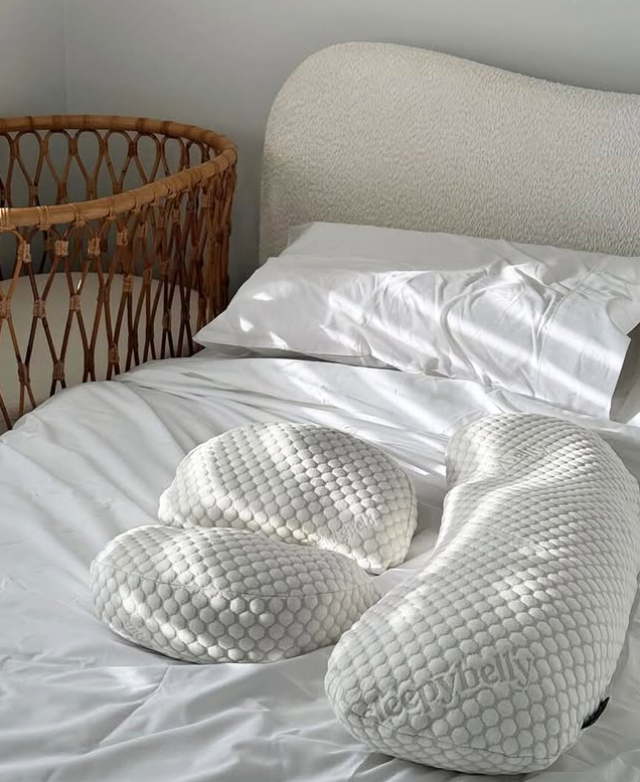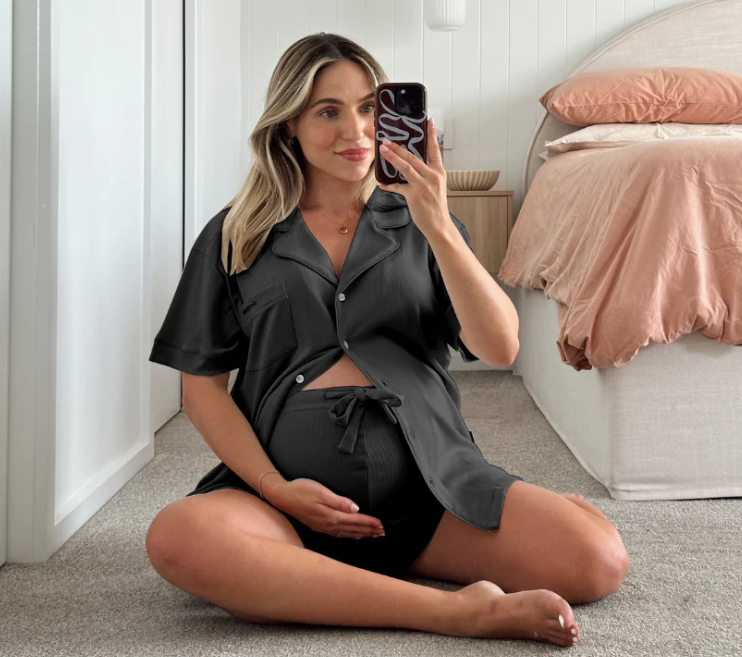You’re growing a tiny human, incredible, right? Between the excitement, hormone rollercoasters, and endless advice flooding your feed, it’s no wonder you’re curious about every heartbeat, kick, and hour of sleep.
And if you’ve started tracking it all on your smartwatch, you’re definitely not alone. From sleep quality to heart rate and even stress levels, wearables in pregnancy have become the new bedtime companion for many mums-to-be.
But here’s the thing: while data can feel empowering, it can also sneakily add pressure, especially when the numbers don’t look “perfect.”

Growing a Baby in the Digital Age
Pregnancy today doesn’t come with just cravings and scans; it comes with data. From heart rate to REM cycles, oxygen levels to movement, wearables have become constant companions for many expecting mums. And for good reason, they promise insights into your sleep, activity, and stress levels when your body feels like it’s changing by the hour.
But while wearables in pregnancy can be empowering, they can also cause unnecessary pressure. When every night’s sleep score feels like a report card, it’s easy to forget what really matters: how you feel, not just what your watch says.
Why Sleep Feels Different During Pregnancy
Even before your bump starts showing, pregnancy hormones begin shifting your body’s rhythm.
-
Progesterone helps relax your muscles and prepare your body for growth, but it can also make you feel more fatigued.
-
Body temperature naturally rises, sometimes making nights warmer and more restless.
-
Digestion slows down, which can trigger heartburn and frequent wake-ups.
-
And of course, your bladder has its own agenda at 2 a.m.
Wearables can help you spot these patterns; seeing how your rest changes across trimesters can be useful, but it’s important not to let those numbers steal your peace.
According to Pregnancy, Birth and Baby (Australian Government), hormonal and physical changes during pregnancy are the main reasons sleep can feel disrupted, especially in the first and third trimesters.
The Good Side of Wearables in Pregnancy
Used with intention, wearables can be brilliant tools for expectant mums. They can help you:
Understand Your Sleep Patterns
See when you’re most restless, track bedtime consistency, and notice which nights you sleep best. It can be surprisingly empowering to identify your “sweet spot” for rest.
Monitor Gentle Activity
Many mums worry about overexertion or inactivity. A wearable helps you see how much light movement you’re getting, such as walking, stretching, and even nesting counts.
Spot Stress Trends
If your resting heart rate or stress index rises, it might remind you to slow down or add more relaxation rituals before bed.
Track Temperature and Breathing
Some devices offer body temperature tracking, which can help you recognise why you’re waking warm or restless.
These insights can support conversations with your midwife or GP, especially if you’re unsure whether your symptoms are typical.
When Wearables Become Too Much
Here’s where it can get tricky. Sometimes, constant tracking starts to feel less like care and more like comparison or control.
If you’ve caught yourself scrolling through your sleep app and feeling anxious (“Why did I only get one hour of deep sleep?”), you’re not alone. Over-tracking can trigger stress, and ironically, that stress can make it even harder to sleep.
A 2022 Sleep Health Foundation review noted that while wearables help identify habits, focusing too heavily on nightly data may lead to “orthosomnia,” the anxiety of not sleeping well because of trying too hard to sleep well.
How to Use Wearables Without Over-Tracking
The goal isn’t to ditch your wearable, it’s to use it mindfully.
Here’s how to keep it a helpful tool rather than a source of pressure:
1. Check Data Once, Not Constantly
Set a boundary: review your sleep data once in the morning, then move on. Avoid opening your app throughout the day, it keeps your mind fixated on restlessness rather than rest.
2. Look for Patterns, Not Perfection
Your sleep will naturally vary night to night. Focus on weekly or monthly trends instead of obsessing over one “bad” night.
3. Reflect on How You Feel
Pair your data with emotion. Did you wake feeling calm, even if your sleep score was low? That’s still a win. Trust your body more than the graph.
4. Track What You Can Influence
Instead of chasing perfect sleep numbers, use data to guide practical changes:
-
Eat dinner earlier to reduce heartburn.
-
Adjust your bedtime routine.
-
Experiment with room temperature or bedding materials.
5. Prioritise Comfort Over Control
Remember, no amount of data can replace a physically supportive environment. Your pillow, bedding, and sleep position often have more impact on your rest than any watch metric.
Creating a Calming Sleep Setup
Comfort is the foundation of restful pregnancy sleep, especially when you’re balancing hormones, body heat, and belly growth.
Here’s how to optimise your sleep environment to work with your wearable insights:
Choose Cooling, Breathable Bedding
Natural fibres like bamboo, linen, and Tencel help regulate temperature and wick away moisture, ideal for hot sleepers or night sweats.
Research from CHOICE Australia notes that bamboo bedding is naturally breathable and great for heat regulation.
Keep Room Temperature Between 18–20 °C
A cooler bedroom supports deeper sleep and reduces reflux or overheating, something your wearable might reflect in steadier heart-rate patterns.
Use Supportive Pregnancy Pillows
The Sleepybelly Pregnancy Pillow is designed to support your bump, back, and hips while keeping airflow around your body. It also slightly elevates your upper body, helping reduce reflux and improving breathing.

Wear Breathable Maternity Pyjamas
Swap synthetic fabrics for lightweight, stretchable sleepwear like the Sleepybelly Maternity Pyjamas, which move with you and keep you cool through the night.
Wind Down With Magnesium Body Cream
Massage a small amount of Sleepybelly Magnesium Body Cream into tired muscles before bed to ease tension, calm your nervous system, and promote deeper relaxation.
Balancing Data with Intuition
One of the most powerful lessons in pregnancy is learning to trust your body.
Your wearable gives you numbers, but your intuition tells you what those numbers mean.
Ask yourself each morning:
-
Do I feel rested, regardless of what my app says?
-
What small change helped me sleep better last night?
-
Is my focus today on wellness or on chasing perfect data?
Sometimes, the most restorative thing you can do is turn off your tracker for a night and simply rest without record-keeping.
When to Talk to Your Doctor
If your wearable highlights concerning trends like consistently high heart rate, poor oxygen readings, or persistent insomnia, it’s worth discussing with your midwife or GP. They can determine whether it’s just pregnancy discomfort or something that needs extra care.
Always rely on professional advice over digital data. Wearables complement, but never replace, proper medical guidance. For trustworthy local information, visit the Pregnancy, Birth and Baby website for evidence-based sleep and wellness advice in pregnancy.
Final Thoughts
Wearables in pregnancy can be wonderful companions when used wisely; they offer insight, not instruction.
They help you understand how your changing body responds to rest, movement, and stress, but they’re not the final word on your wellbeing.
When you balance technology with intuition, pairing data awareness with physical comfort, breathable bedding, and emotional calm, you create the perfect environment for better sleep and a healthier pregnancy.
So go easy on yourself, Boss. You’re growing a life that’s more powerful than any data point. And when you’re ready to make your sleep space as nurturing as your intentions, explore the full Sleepybelly range of pregnancy pillows, maternity pyjamas, and magnesium body care.
Better sleep starts with you, not your stats.



